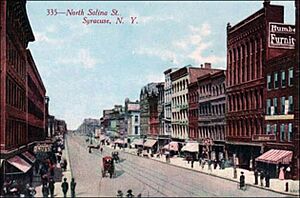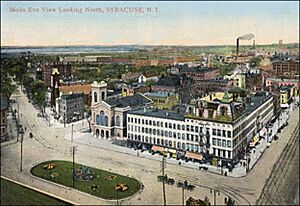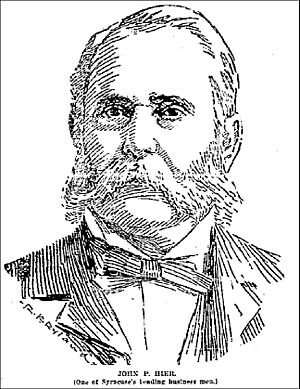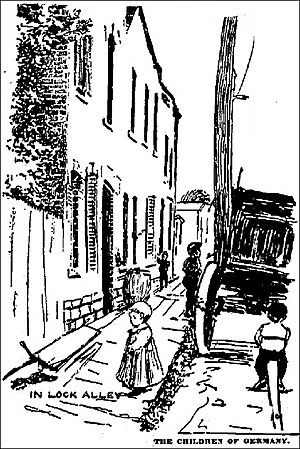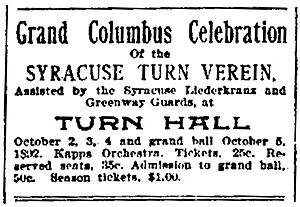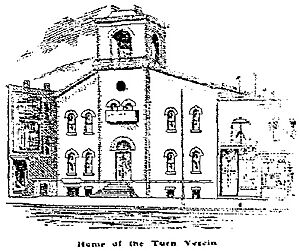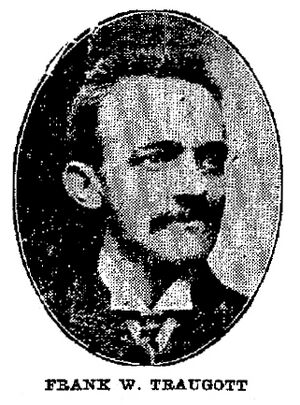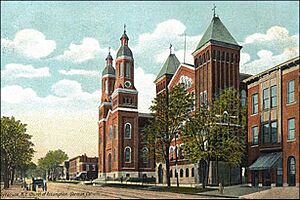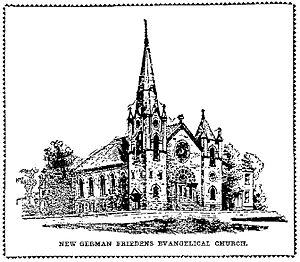Germans in Syracuse, New York facts for kids
A German mission was set up in Onondaga County, New York in 1750 by Moravian missionaries from Pennsylvania. However, most of the first Germans who arrived in this area didn't stay for long.
The German immigrants who first settled in the farmlands around Syracuse in the early 1800s came from all over Germany. This included Alsace, which was part of France at the time. In the 1820s and 1830s, most came from Southern Germany, especially places like Baden, Bavaria, Hesse-Darmstadt, and Württemberg. These areas had been badly affected by the Napoleonic Wars. Later, people arrived from Northern Germany, including Franconia, Lorraine, and Prussia.
By 2010, about 12.2% of the people in Syracuse had German family roots.
Contents
- History of German Settlers in Syracuse
- Early Visits by Moravian Missionaries
- Waves of German Immigration to America
- First German Families in Syracuse
- German Community Growth
- German Musical Groups
- The Turner Movement
- German Fraternal Groups
- German Clubs and Associations
- Delicious German Foods
- German Influence in Politics
- German Churches and Synagogues
- German Volunteer Firefighters
- The Twentieth Century and German Identity
- German Events and Culture
History of German Settlers in Syracuse
Early Visits by Moravian Missionaries
In 1750, a group called the Moravian brothers arrived in Onondaga. This was the main town of the Six Nations in Central New York. The missionaries stayed with the chief, who welcomed them. Their goal was to keep a promise made in 1749 to the Iroquois leaders in Philadelphia, Pennsylvania. They also wanted permission to live among the Iroquois to learn their language and "preach the gospel." The mission stayed for six years but didn't achieve much.
Waves of German Immigration to America
German immigration to the U.S. really started around 1821. About 2,200 Germans arrived that year. By 1830, the number grew to 15,000 in one year. It kept rising, reaching 33,000 by 1837. After a dip, it jumped to 44,000 in 1844. In 1845, 67,000 Germans found new homes in America. During the years of the French Revolution of 1848, the numbers went up to 90,000. By 1850, over 113,000 Germans had settled in the United States.
Some Germans arrived in the Syracuse area before 1821. They settled in Manlius and other parts of Onondaga County. For example, Johannes A. Schaeffer ran an inn in Manlius village as early as 1792.
In the 1800s, Germans helped start several important industries in Syracuse. One group settled in the heart of the Onondaga Salt Springs Reservation, near the village of Liverpool. They developed the willowware industry, which was famous for 50 years.
First German Families in Syracuse
Conradt Busch was one of the earliest settlers in Central New York. He moved to Lewis County after working for George Washington during the Revolutionary War. After the war, he received land in the town of Pompey in 1791.
Many other towns in Central New York, like Cicero, Salina, and Otisco, also had German settlers.
The first German settlers within what is now Syracuse were John Jacob Mang, Christian Usenbents, and Henry Philip Bentz. They originally came from Swabia, a part of the Kingdom of Württemberg in Germany. They first settled in Baltimore, Maryland.
Mang arrived around 1797, and Usenbents and Bentz came in 1800. Mang was a doctor in Germany but didn't practice medicine after settling in Salina in 1804.
Mang and Usenbents started making salt, which was a big business in Salina. Mang was the "scientist," and Usenbents was the "businessman." By 1812, Usenbents owned four salt blocks. Mang later left the business and settled on land near the Onondaga Salt Springs Reservation. Usenbents bought land in 1825 and planted a fruit garden. Mang's house was on North Salina Street, where he made wine and cider. He passed away in 1842 at age 84.
Usenbents died in 1832 at age 65. His son, Christian Usenbents, born in 1808, was the first child born to German parents in what is now Syracuse. Bentz, Usenbents' brother-in-law, also worked in the salt business until 1813. He died in 1865 in Salina at age 84.
Usenbents and Bentz became U.S. citizens in Onondaga County in 1814. This was the first recorded German naturalization in the county.
In 1833, a group from Hesse-Darmstadt, Germany, moved from Cape Vincent, New York, to Syracuse. This group included Ernst Hoecher, Frederick Schnauber, John Miller, and George Lupp with their families. Hoecher's name was later changed to "Hier" by his neighbors. His oldest son, George P. Hier, became Mayor of Syracuse in 1875, the first German to hold that office. Another son, John P. Hier, was a cigar maker.
After 1833, more German immigrants settled quickly because the salt industry was growing. By 1840, there were over 1,000 Germans in Onondaga County.
In 1898, John P. Hier was one of the oldest merchants in Syracuse. He built the "largest tobacco establishment and business" in Central New York. He started working at age eight, stripping tobacco. He opened his own cigar business in 1860. His first shop was small, but over 30 years, his factory employed over 400 workers.
Hier owned a lot of property in Syracuse. In 1888, he built The Hier Haus, a seven-story apartment building on West Willow Street. It housed nearly 100 families and had "all the modern and up-to-date improvements."
German Community Growth
In 1891, Syracuse had about 90,000 people. Around 25,000 of them were German, with about 20,000 born in the U.S. Most Germans lived in specific areas, especially the Second Ward, which was 90% German. By 1897, Germans were the largest foreign-born group in Syracuse, and 25,000 people spoke German.
By 1900, most German residents lived on the Northside of the city.
Most of the Syracuse German children were born here and learned first the English and afterward the German language. One blonde little Teutonic maid related her experiences in the beginning her mother tongue. The first word she mastered was "knee." "That's cheese, you know", she said, and after that she was taught the German for all the articles of food and the common objects in the home and street. - Syracuse Herald, October 1899.
Even though they shared a language, German immigrants in Onondaga County sometimes felt like foreigners to each other. This was because they came from many different parts of Europe that are now Germany and spoke many different dialects.
German Musical Groups
The German Brass Band was formed in 1848 with Jacob Samsel as its leader. They played together for many years and were later known as "Samsel's Brass Band."
In 1851, the German Musical Institute was started with George Saul as leader. They met twice a week. In 1853, Miller's Brass Band was organized by Casper Miller.
The first singing group was the Siungerbund, which had about 20 members. It grew from a quartet. This group only lasted two years.
On October 5, 1855, the Gesangverein Syracuse Liederkranz was formed with thirteen members. It met at the old National Hotel. By 1891, this group had been around for over 35 years and was one of the leading German Liederkranz societies in the country.
The Verein met at their hall and became an official organization in 1889. Many Syracuse business leaders were part of the group, which had 150 members.
In 1857, the Concordia group was organized. For many years, it was a friendly rival to the Liederkranz. It had about 50 members.
In 1873, the Fifth Ward Siungerbund was organized with Professor Heinrich Regener as Director. It had about 25 members. In 1889, the Arbeiter Liedertafel was formed with about 40 members. Professor Henri Bitter was the director.
In 1896, the Arion Singing Society of Syracuse was formed. From the 1960s to the 1990s, their club was in the former Evangelical Lutheran Church of the Redeemer building.
The Turner Movement
The Turner movement started in Germany in the early 1800s. It aimed to free German states from Napoleon's rule. It mixed "patriotic and liberal principles with an emphasis on physical training."
The French Revolution of 1848 caused many German speakers to move to America. It also led to the creation of the German-American Turn Verein, or Turner movement. In the U.S., Germans wanted to create the same gymnastics clubs they had back home. These clubs promoted German physical education and helped preserve their customs, languages, and celebrations.
In its early days in the U.S., the Turn Verein was seen as a radical group. Its ideas were similar to those of German "freethinkers' societies."
Some of the group's main beliefs included being against slavery, against alcohol bans, and against anti-immigrant feelings. The group strongly supported the Bill of Rights. They also pushed for free public education and the separation of church and state. They supported cultural events like concerts and theater. They also wanted laws to protect American workers, especially farmers. Turn Verein groups were against the strict rules of all churches.
Syracuse Turners
The Turn Verein offered "friendly gathering places" for Germans across the country. They also provided physical fitness programs and helped Germans blend their old culture with their new life in America.
The Turn Verein in Syracuse was started on May 15, 1854. At first, there were fewer than 20 members. They followed the ideas of Friedrich Ludwig Jahn, who founded the German gymnastics system. The Turners first met in a small house on Pearl Street. Peter Baumgrass was the first president.
The Syracuse group moved to a vacant lot on North Salina Street. In 1860, their building burned down, and the Turners lost everything. The group had grown to 150 members before the fire but was reduced to 20. They bought land on Pond Street and built a one-story building. In 1863, the club moved to the corner of Lodi and John streets, where they built the Turn Hall.
In 1879, the club was called Scheutzen Verein. Meetings were held on the first Thursday of each month.
In late August 1882, the Turners State Convention was held in Syracuse, with the local Turn Verein hosting the event.
By February 1893, the Turners "athletic school" was the oldest in the city. The equipment was old and worn. Classes had 50 men and 250 boys and girls. Attendance grew so fast that year that they needed new space.
Soon after, the Turn Verein members decided to update their "gymnasium department." They bought new equipment to make the gym "second rate to none" in the city. Bathrooms, which had been missing, were also installed, making members very happy.
Almost as soon as a child can walk it goes into one of the classes of the Turn Verein, and the North side abounds in athletic youngsters as sturdy and healthy as wholesome surroundings and sensible habits can make them. - Syracuse Herald, October 1899.
Professor Carl Grosse was hired as the physical instructor in 1893. Under his guidance, "many remarkable athletes" were trained. He was born in Leipaic, Germany, in 1853 and showed a natural talent for gymnastics from a young age.
The Turners were deeply connected to all parts of German-American life in Syracuse. The Gemuelichkeit festival, run by the Turn Verein, was a highlight for early Germans during Thanksgiving.
Turners and the Civil War
During the American Civil War (1861–1865), many German immigrants in New York State served in the Twentieth Regiment, New York State Volunteer Infantry. This group was also known as Turnschützenregiment (the United Turner Rifles).
Leaders of the Turn Verein
The organization was founded on May 15, 1854, with Peter Baumgrass as the first president. On January 15, 1937, Syracuse Mayor Rolland B. Marvin praised the Turn Verein. He called it "one of the greatest organizations this city has ever known" and a "real asset" to Syracuse.
Here are some of the presidents:
- Peter Baumgrass (1854-?)
- Frank W. Traugott (19?-1912)
- William E. Sembach (1912–1916)
- Charles A. Latterner (1918–1920)
- George Bretzer (1920–1922)
- Joseph Ehegartner (1923–1925)
- Otto E. Schoeneck (1932–1935)
- Frank Halsig (1930–1932)
- Joseph E. Kuehlman (1936-?)
German Fraternal Groups
The strong community spirit among Germans in Syracuse was clear from the many clubs and groups they formed.
One important group was the German Order of Harugari. This group's rules said that only German could be used in meetings. It also aimed to preserve the German language. By 1850, Syracuse Lodge No. 30 was organized. It existed until 1857, when most members joined the Independent Order of Odd Fellows. No Harugari lodges were in Syracuse until 1867, when Central City Lodge No. 154 was formed.
All the North side is an interesting place for children. Games of all kinds and children's festivals receive the greatest attention. Besides Christmas, New Years and Easter, there are many other occasions celebrated strictly for the children. There are customs brought from Germany. Parents like to remember and perpetuate the child plays of the Fatherland, and so they teach them to their children. - Syracuse Herald, October 1899.
The Independent Order of Odd Fellows started Schiller Lodge No. 408 in 1849. In 1867, its name changed and it joined Lessen Lodge No. 116.
The second German lodge, LaFayette Lodge No. 489, started in 1857. In 1866, it joined Lincoln Lodge No. 180. This was the only club in Syracuse that owned its own hall. It was a "beautiful brick structure" built in 1887.
Other groups also used German, like Onondaga Lodge No. 190 of the Knights of Pythias. Many other lodges and councils were German, too. While there wasn't a specific German Free Masons lodge in Syracuse, Germans were part of Syracuse Lodge No. 501 and Salt Springs Lodge No. 520.
The Bavarian Club Almenrausch was founded in 1972. Its goal is to keep Bavarian customs alive, including Tracht (costumes), Schuhplatteln (traditional shoe slapping dances), and folk dances.
German Clubs and Associations
In 1879, the Syracuse German Benefit Society was active. John Geyer was president. The club met twice a month.
The German Rifle Association, organized in 1868, met once a month. By 1879, Benedict Haberle was president.
Delicious German Foods
Hofmann Sausage was founded in Syracuse in 1879. They make many types of sausages, including Snappys (also known as Coney Dogs), which are special to the Central New York region.
The company also makes German Frankfurter, Knackwurst, Kielbasa links, Bratwurst, Bologna, Liverwurst, and Italian Sausage. These are often served with German-style mustard and sauerkraut. The company is located at 6196 Eastern Avenue.
Danzer's German & American Restaurant was started in 1946 by Ludwig Danzer. For over five decades, it has served homemade German meals. They are known for their imported beers and "giant" deli sandwiches. Other popular dishes include Hot German Potato Salad, Potato Dumplings, Buttered Noodles, Red Cabbage, German Sauerkraut, Cole Slaw, Deli Corned Beef, Chicken Schnitzel, Jäger Schnitzel, Hot Pastrami on Rye, Sauerbraten, Schnätzeli, Reuben, Beef Rouladen, Wiener Schnitzel, German Potato Pancakes, and Limberger with onion.
German Influence in Politics
The first German alderman (a city council member) elected in Syracuse was Harmon Ackerman in 1852.
German Churches and Synagogues
When Christian German immigrants first arrived in Onondaga County in the 1830s, they were surprised. In America, there were no state-supported churches like in Germany. This meant they had to build and maintain their own churches to continue their religious practices. This was a new responsibility for them. Immigrants began forming congregations, like St. John's Lutheran Church, which started in 1838.
A big challenge was the lack of priests and ministers to serve the immigrants. Early German pioneers had to work hard to find religious leaders and build churches that would be centers for both social and religious life. The Germans included both Roman Catholic and Protestant Christians.
Building a meeting place and paying a pastor's salary was expensive. This often meant great sacrifice, with families even mortgaging their homes. As the community grew, disagreements sometimes led members to form new congregations. By 1863, two new German-American Lutheran churches, St. Peter's and Zion, had joined St. John's.
Some members of Saint Peter's and their pastor, Johannes Schaeffer, left in 1900 to form the Deutsche Evangelische Friedenskirche (German Evangelical Peace Church). This is now the Friedens United Church of Christ. By May 1901, work began on the new church, which cost $15,000. It was designed by architect Archimedes Russell. The church could seat 400 people and had 200 German members from the Northside.
It seems that many Jewish people who settled in Syracuse also spoke German. The first Jewish congregation, Keneseth Shalom (Society of Concord), was officially formed in 1842. A small wooden synagogue was built in 1846. In 1851, a larger synagogue was opened. The opening speeches were given in German, and some services were in German until at least the 1880s.
German Volunteer Firefighters
A German volunteer fire department was organized around 1850. By 1891, it was considered "one of the best in the state." Philip Eckel, the Chief, died in 1886. Engine House 3 was on West Willow Avenue, and Engine House 4 was on Division Street. Both companies disbanded when the official Syracuse Fire Department was created.
The Twentieth Century and German Identity
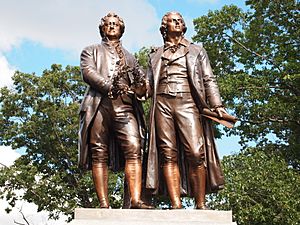
The 1900s brought changes for Syracuse's German-American community. After a high point in 1911 with the dedication of the Goethe–Schiller Monument, World War I began. Anti-German sentiment during the war made people less likely to speak German in public. For example, Friedens Evangelical church started a separate English-language service at that time. During World War II, Friedens stopped its German-language service completely.
German Events and Culture


